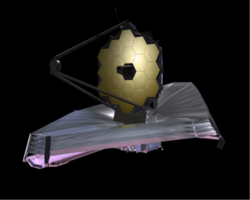The James Webb Space Telescope (sometimes called JWST) is a large, infrared-optimized space telescope. The project is working to a 2018 launch date. Webb will find the first galaxies that formed in the early Universe, connecting the Big Bang to our own Milky Way Galaxy. Webb will peer through dusty clouds to see stars forming planetary systems, connecting the Milky Way to our own Solar System. Webb’s instruments will be designed to work primarily in the infrared range of the electromagnetic spectrum, with some capability in the visible range.

The James Webb Space Telescope
Photo Courtesy of Northrop Grumman
Webb will have a large mirror, 6.5 meters (21.3 feet) in diameter and a sunshield the size of a tennis court. Both the mirror and sunshade won’t fit onto a rocket fully open, so both will fold up and open once Webb is in outer space. Webb will reside in an orbit about 1.5 million km (1 million miles) from the Earth.
The James Webb Space Telescope was named after the NASA Administrator who crafted the Apollo program, and who was a staunch supporter of space science. – http://www.jwst.nasa.gov/
Pacamor Kubar Bearings (PKB) extremely high precision specialty ball bearings are found in many challenging aerospace and defense applications. PKB’s specialty ball bearing designs are found in near-earth and cryogenic missions, life-sustaining survival suits for space exploration, public and private rocket launches and well known NASA space projects.
PKB manufactures a wide variety of specialty ball bearings for space vehicles, guidance systems, array mechanisms, flow meters and flow control units that are used in some pretty extreme environments like the James Webb Space Telescope or JWST.






